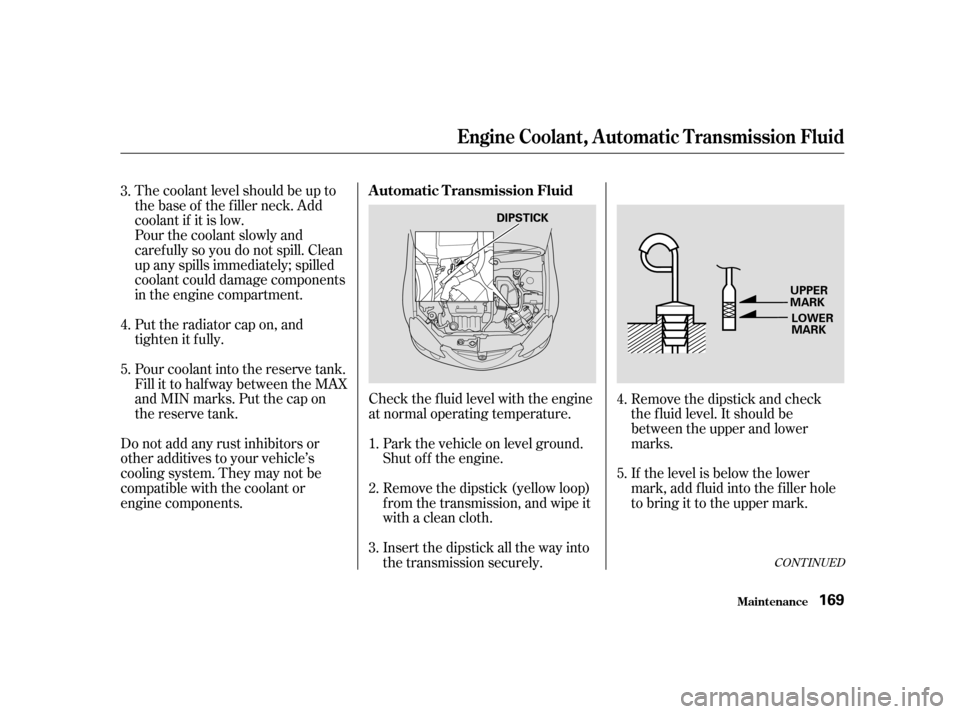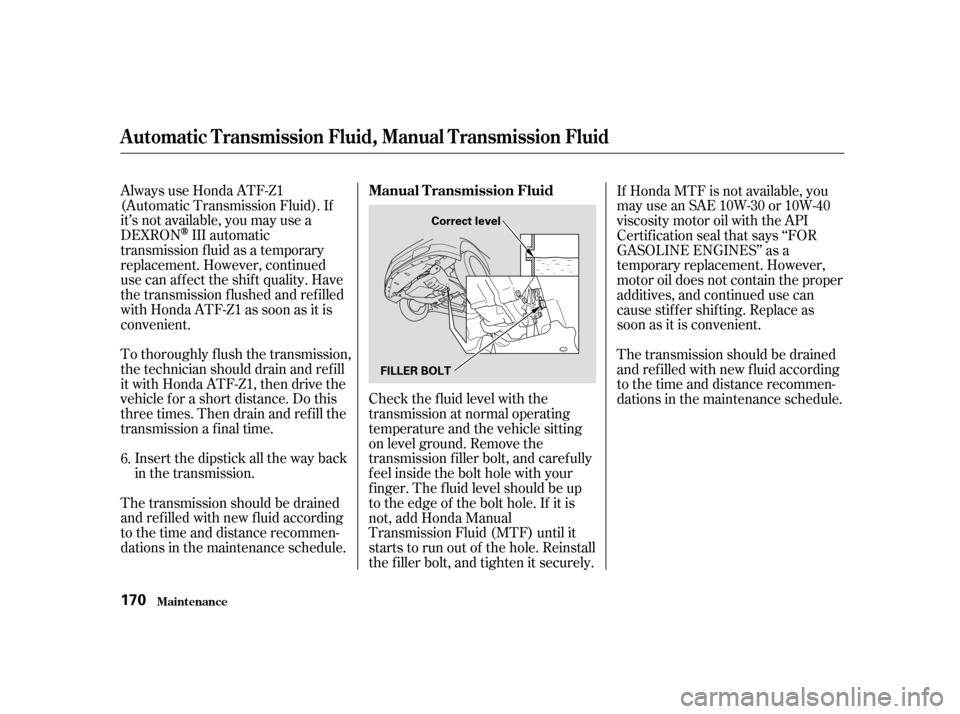ECU Acura RSX 2004 Owner's Guide
[x] Cancel search | Manufacturer: ACURA, Model Year: 2004, Model line: RSX, Model: Acura RSX 2004Pages: 250, PDF Size: 3.3 MB
Page 137 of 250

Youshoulddothefollowingchecks
and adjustments every day bef ore
you drive your vehicle.Make sure all windows, mirrors,
and outside lights are clean and
unobstructed. Remove f rost, snow,
or ice. Check the seat adjustment (see
page ).
Check the adjustment of the
inside and outside mirrors (see
page ).
Check the steering wheel
adjustment (see page ).
Make sure the doors and hatch
are securely closed and locked.
Fasten your seat belt. Check that
your passengers have f astened
their seat belts (see page ).When you start the engine, check
the gauges and indicators in the
instrument panel (see page ).
Check that the hood is f ully closed.
Visually check the tires. If a tire
looks low, use a gauge to check its
pressure.
Check that any items you may be
carrying are stored properly or
f astened down securely.
1.
2.
3.
9. 8.
7. 6. 5.
4. 10.
72
6214 49
80
Preparing to Drive
Driving134
Page 154 of 250

The best way to conf irm that vehicle
and trailer weights are within limits
is to have them checked at public
scale.
Using a suitable scale or a special
tongue load gauge, check the tongue
load the f irst time you set up a
towing combination (a f ully-loaded
vehicle and trailer), then recheck the
tongue load whenever the conditions
change.Towing can require a variety of
equipment, depending on the size of
your trailer, how it will be used, and
how much load you are towing.
Discuss your needs with your trailer
sales or rental agency, and f ollow the
guidelines in the rest of this section.
Also make sure that all equipment is
properly installed and that it meets
f ederal, state, province, and local
regulations.Any hitch used on your vehicle must
be properly bolted to the underbody.
Always use saf ety chains. Make sure
they are secured to both the trailer
and hitch, and that they cross under
the tongue so they can catch the
trailer if it becomes unhitched.
Leave enough slack to allow the
trailer to turn corners easily, but do
not let chains drag on the ground.
CONT INUED
Towing a Trailer
Checking L oads
T owing Equipment and
A ccessoriesHitches
Saf et y Chains
Driving151
Page 167 of 250

Make sure the API Certif ication Seal
says ‘‘For Gasoline Engines’’.
The oil’s viscosity or weight is
provided on the container’s label.
5W-20 oil is f ormulated f or year-
round protection of your Acura, to
improve cold weather starting and
f uel economy.
To add oil, unscrew and remove the
engine oil f ill cap on top of the valve
cover.
Pour in the oil slowly and caref ully so
you do not spill. Clean up any spills
immediately. Spilled oil could
damage components in the engine
compartment.
Install the engine oil f ill cap and
tighten it securely. Wait a f ew
minutes and recheck the oil level. Do
not f ill above the upper mark on the
dipstick; you could damage the
engine. Oil is major contributor to your
engine’s perf ormance and longevity.
Always use a premium-grade
detergent oil displaying the API
Certif ication Seal. This seal indicates
the oil is energy conserving, and that
it meets the American Petroleum
Institute’s latest requirements. It is
highly recommended that you use
Honda motor oil in your vehicle.
RSX and Premium models
A dding Engine Oil
Maint enance
Recommended Oil
164
ENGINE OIL FILL CAP
API CERTIFICATION SEAL Ambient Temperature
Page 172 of 250

CONT INUED
The coolant level should be up to
the base of the f iller neck. Add
coolant if it is low.
Pourthecoolantslowlyand
caref ully so you do not spill. Clean
up any spills immediately; spilled
coolant could damage components
in the engine compartment.
Put the radiator cap on, and
tighten it fully.
Pour coolant into the reserve tank.
Fill it to half way between the MAX
and MIN marks. Put the cap on
the reserve tank.
Do not add any rust inhibitors or
other additives to your vehicle’s
cooling system. They may not be
compatible with the coolant or
engine components. Check the f luid level with the engine
at normal operating temperature.
Park the vehicle on level ground.
Shut of f the engine.
Remove the dipstick (yellow loop)
f rom the transmission, and wipe it
with a clean cloth.
Insert the dipstick all the way into
the transmission securely. Remove the dipstick and check
the f luid level. It should be
between the upper and lower
marks.
If the level is below the lower
mark, add f luid into the f iller hole
to bring it to the upper mark.
1.
2.
3.
4.
5.
3.4.
5.
Engine Coolant, Automatic Transmission Fluid
Maint enance
Automatic Transmission Fluid
169
DIPSTICK
UPPER
MARKLOWER
MARK
Page 173 of 250

Always use Honda ATF-Z1
(Automatic Transmission Fluid). If
it’s not available, you may use a
DEXRON
III automatic
transmission f luid as a temporary
replacement. However, continued
use can affect the shift quality. Have
the transmission f lushed and ref illed
with Honda ATF-Z1 as soon as it is
convenient.
To thoroughly f lush the transmission,
the technician should drain and ref ill
it with Honda ATF-Z1, then drive the
vehicle f or a short distance. Do this
three times. Then drain and ref ill the
transmission a f inal time.
Insert the dipstick all the way back
in the transmission.
The transmission should be drained
and ref illed with new f luid according
to the time and distance recommen-
dations in the maintenance schedule. Check the f luid level with the
transmission at normal operating
temperature and the vehicle sitting
on level ground. Remove the
transmission f iller bolt, and caref ully
f eel inside the bolt hole with your
f inger. The f luid level should be up
to the edge of the bolt hole. If it is
not, add Honda Manual
Transmission Fluid (MTF) until it
starts to run out of the hole. Reinstall
the f iller bolt, and tighten it securely.If Honda MTF is not available, you
may use an SAE 10W-30 or 10W-40
viscosity motor oil with the API
Certif ication seal that says ‘‘FOR
GASOLINE ENGINES’’ as a
temporary replacement. However,
motor oil does not contain the proper
additives, and continued use can
cause stiffer shifting. Replace as
soon as it is convenient.
The transmission should be drained
and ref illed with new f luid according
to the time and distance recommen-
dations in the maintenance schedule.
6.
A ut omat ic T ransmission Fluid, Manual T ransmission Fluid
Maint enance
Manual Transmission Fluid
170
Correct level
FILLER BOLT
Page 178 of 250

Insert the new bulb into the hole,
making sure the tabs are in their
slots. Pivot the hold-down wire
back in place, and clip the end into
the slot.
Install the rubber seal and make
sure it is right side up; it is marked
‘‘TOP.’’
Push the electrical connector onto
the tabs of the new bulb. Make
sure it locks in place.
(Passenger’s side)
Install the power steering
reservoir on the bracket.
Remove the electrical connector
f rom the bulb by pulling the
connector straight back.
Remove the rubber weather seal
by pulling on the tab.
Unclip the end of the hold-down
wire f rom its slot. Pivot it out of
the way, and remove the bulb.
If you need to change a headlight
bulb on the driver’s side, remove
the bolt from the battery hold-
down, and caref ully push the
battery toward the windshield to
obtain enough working space.
Pull the battery back to its original
position, then install the bolt in the
hold-down, and tighten it securely. (Driver’s side)
3.
4. 5.
6.
7.
8.
2.
Lights
Maint enance175
BULB
WEATHER
SEAL
HOLD
DOWN WIRE CONNECTOR
Driver’s side
Page 180 of 250

Pull the bulb straight out of its
socket.
The f ront parking bulb is next to
the headlight bulb.
Remove the socket from the
headlight assembly by turning it
one-quarter turn counterclockwise.
Install the new bulb into the
socket.
(Passenger’s side)
Install the power steering
reservoir on the bracket.
(Driver’s side)
Place the battery in its original
position, then install the bolt in the
hold-down, and tighten it securely.
Install the new bulb into the
socket.
3.
4.
5.
1.
2.4.
Replacing a Front Parking Bulb
Lights
Maint enance177
BULB
Page 199 of 250

Tighten the wheel nuts securely in
the same crisscross pattern. Have
the wheel nut torque checked at
the nearest automotive service
f acility.
Tighten the wheel nuts to:
Put on the spare tire. Put the
wheel nuts back on f inger-tight,
then tighten them in a crisscross
pattern with the wheel wrench
until the wheel is f irmly against
the hub. Do not try to tighten
them f ully.
Lower the vehicle to the ground
and remove the jack.
15.
13.
14.
Changing a Flat T ire
T aking Care of t he Unexpect ed196
(Except Type-S)
80 lbf·ft (108 N·m , 11 kgf·m)
Page 200 of 250

Store the jack in its holder. Turn
the jack’s end bracket clockwise to
raisethejackandlockitinplace.
Screw the adapter into the hole in
the spare tire well.Remove the wheel cover or center
cap and place the flat tire face
down in the spare tire well.
Set the bass speaker inside the
wheel.
Secure the f lat tire with the wing
bolt.
Remove the spacer cone f rom the
wing bolt, turn it over, and put it
back on the bolt.
18.
16.
17. 20.
21.
Type-S only: Type-S only:
19.All except Type-S:
CONT INUED
Changing a Flat T ire
T aking Care of t he Unexpect ed197
ADAPTER (Type-S only) WING BOLTSPACER
CONE
Page 201 of 250

Store the tool kit.
Store the wheel cover or center
cap in the cargo area. Make sure it
will not get scratched or damaged.Diagnosing why your engine won’t
start f alls into two areas, depending
on what you hear when you turn the
key to START (III):
You hear nothing, or almost
nothing. The engine’s starter
motor does not operate at all, or
operates very slowly.
You can hear the starter motor
operating normally, or the starter
motor sounds like it is spinning
f aster than normal, but the engine
does not start up and run. When you turn the ignition switch to
START (III), you do not hear the
normal noise of the engine trying to
start. You may hear a clicking sound
or series of clicks, or nothing at all.
Check these things:
Check the transmission interlock.
If you have a manual transmission,
the clutch pedal must be pushed
all the way to the f loor or the
starter will not operate. With an
automatic transmission, it must be
in Park or Neutral.
Turn the ignition switch to ON (II).
Turn on the headlights and check
their brightness. If the headlights
are very dim or don’t light at all,
the battery is discharged. See on page .
Reinstall the f loor mat and spare
tire cover, then close the hatch.
22.
23.
24.
200
Changing a Flat Tire, If the Engine Won’t Start
T aking Care of t he Unexpect ed
If the Engine Won’t StartNothing Happens or the Starter
Motor Operates Very Slowly
Jump Starting
198
Loose items can fly around the
interior in a crash and could
seriously injure the occupants.
Store the wheel, jack, and tools
securely before driving.